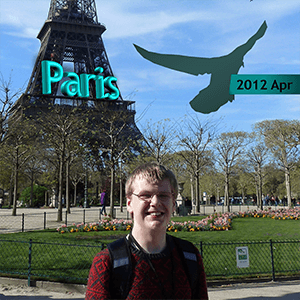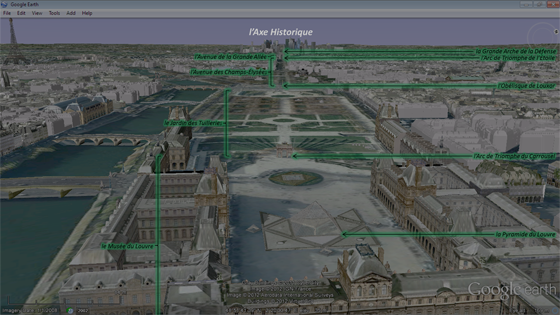 Article for 2012 Apr 04
Article for 2012 Apr 04
Part of the “Paris” series.
2012

2012 Apr
Apr 04 Wed 
I’m going to try to avoid irony in this article.
I’ve better things to think about.
I’d like to swap the ironic for the iconic.
Like the visit to the avenue of the Elysian fields (a.k.a. l’Avenue des Champs-Élysées). The Elysian fields are the Ancient Greeks’ equivalent of Heaven - blessed heroes would spend their afterlife blissfully in the Elysian fields while commoners plodded around Hades. My experience of the Champs-Élysées made me feel like a commoner plodding around Hades. (And I was wanting to avoid irony.)
We were given half an hour of free time to wander around the shops. As we had to stay in groups of four or more, that meant hanging for twenty minutes in an outrageous shop, while one of our party chose a present for his mum, and while the shop-assistant wrapped and packaged and wrapped it.
 Studying the Arc de Triomphe was more favourable. We had to use a subway to access it (as if we weren’t in the Underworld already), because the square it’s in (le Place Charles de Gaulle) is too traffic-laden for pedestrians. It’s a nice arch, the larger of two Arcs de Triomphe built by Napoleon. This arch (l’Arc de Triomphe de l’Étoile) was designed in 1806 to celebrate one of Napoleon’s victories, but is probably better known for housing a Tomb of the Unknown Soldier (le tombe du soldat inconnu) and the first eternal flame in Europe since the 7th century.
Studying the Arc de Triomphe was more favourable. We had to use a subway to access it (as if we weren’t in the Underworld already), because the square it’s in (le Place Charles de Gaulle) is too traffic-laden for pedestrians. It’s a nice arch, the larger of two Arcs de Triomphe built by Napoleon. This arch (l’Arc de Triomphe de l’Étoile) was designed in 1806 to celebrate one of Napoleon’s victories, but is probably better known for housing a Tomb of the Unknown Soldier (le tombe du soldat inconnu) and the first eternal flame in Europe since the 7th century.
 At the other end of the Champs-Élysées is le Place de la Concorde, with l’Obélisque de Louxor. We didn’t stop there; we went round about the roundabout in our coach, and then got out at the Tuilleries Gardens, between the Obelisk and le Musée du Louvre. We didn’t have enough time to have a decent look around the Gardens, in my opinion, though I did enjoy seeing a pigeon on one of the statues.
At the other end of the Champs-Élysées is le Place de la Concorde, with l’Obélisque de Louxor. We didn’t stop there; we went round about the roundabout in our coach, and then got out at the Tuilleries Gardens, between the Obelisk and le Musée du Louvre. We didn’t have enough time to have a decent look around the Gardens, in my opinion, though I did enjoy seeing a pigeon on one of the statues.


 We passed under the second Arc de Triomphe (L’Arc de Triomphe du Carrousel, above), which is smaller than the main arch and has a sculpture of a chariot atop it. The main arch features in the right-hand photo.
We passed under the second Arc de Triomphe (L’Arc de Triomphe du Carrousel, above), which is smaller than the main arch and has a sculpture of a chariot atop it. The main arch features in the right-hand photo.
After the brisk walk, we arrived at the Louvre, where we had time to relax. This was because we were queuing, an activity familiar and thus relaxing to such Brits as us.
I spent my time eating a packed lunch, and musing on the Historical Axis: a line of notable buildings in Paris, with the Louvre at one end and that skyscrapered1 district La Défense at the end. The Champs-Élysées forms part of this Axe Historique, as does the middle path through the Tuilleries Gardens, and both Arcs de Triomphe. The graphic - imagery courtesy of Google Earth - illustrates this:
Once we were in the Louvre proper, we didn’t get much time to admire the paintings.
I wasn’t surprised. It didn’t help that I managed to get stuck in a crowd, and when I had finished twisting my head to discern what the crowd was looking at, my initial thought was “Oh, that again.” (“That” was the Mona Lisa.)
I eventually wriggled out of the crowd, and out of the Louvre. Next on our whistle-stop tour was Notre Dame de Paris, the cathedral serving Paris. For some reason the interiors of all big churches look similar to me. Dark and mystical, and unphotographable. On the other wing, the pigeons outside were very photographable. Predictably.
I indulged in a bit of déjà flew.
And then we flew.
Footnote
1. If a guy called Skye sold pancakes there, I’d say La Défense was Skye’s-Crêpe-ered.





